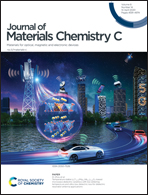Highly sensitive, selective and stable NO2 gas sensors with a ppb-level detection limit on 2D-platinum diselenide films†
Abstract
Unlike common TMDCs such as MoS2, PtSe2 can be fabricated at temperatures below 600 °C, or even as low as 300 °C, while still maintaining high quality. By varying the selenization temperature from 300 °C to 600 °C, the electrical properties were changed significantly, resulting in superior gas sensing performance. Through comprehensive material analysis, an interesting phenomenon was found, namely that strain along the [001] direction existed in films grown at a low temperature rather than at a high temperature. Moreover, due to the layer-dependent property of PtSe2, a phase transition from metal-to-semiconductor occurs as the thickness is reduced. Hybridization of phase engineering and thermal strain engineering significantly enhances the gas sensing performance, resulting in PtSe2 with a dramatic increase in the response to 1 ppm NO2 from 25% to 550% once the thickness was reduced from 10 to 5 layers. In addition, PtSe2 showed good stability during exposure to not only 1 ppm but also 50 ppb NO2 for more than 5 cycles with responses of over 550% and 60%, respectively.



 Please wait while we load your content...
Please wait while we load your content...